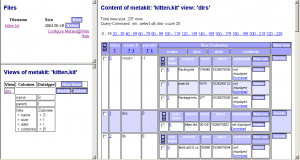Metakit@Web is a web-based admin-interface for metakit-files
Metakit@Web is a web-administration-interface for metakit-files and works with Tclhttpd. It’s like the well known phpMyAdmin but only for metakit-database-files and only suited for the real tcl-webserver.
News
- June 04 – Metakit@Web (0.5) is now distributed as a sample-app in TclHttpd 3.5.1
- April 04 – Jean-Claude Wippler has built a starkit of Metakit@Web (downloadable at http://www.equi4.com/pub/sk/mkatweb.kit) – Thanks Jean-Claude.
- February 04 – Released version 0.6
Introduction
Metakit@Web is an administration-interface written for TclHttpd. It can be used to administrate metakit-database-files. I’m using it as a rapid-prototyping-tool to develop data-models and quickly store and edit data.
The features of Metakit@Web (version 0.6) in detail:
- easy installation in TclHttpd (just extract the zip-file into your htdocs-directory)
- easy creating, editing, manipulating Metakit-files (useful for rapid-prototyping)
- easy browsing through content of Metakit-files
- if you have stored images inside you metakit, you can easily look at them through the browser-interface
- session-support (with row-locking) (not supported by 0.5)
- htaccess-support (not supported by 0.5)
- multi language-support (thanks to Miko le pépé) (not supported by 0.5)
There are now two different versions of Metakit@Web with two different techniques used.
- version 0.5: consists of only one file and is implemented as a Direct_Url
- version 0.6: is a htdocs-directory and allows you to have .htaccess files and sessions.
Version 0.5 can still be downloaded but I won’t do any more work on it.
Here is a screenshot of Metakit@Web (0.5/0.6):

Installation
Installation is quite simple (as always with Tclhttpd):
- Download mkatweb_06.zip
- Extract the zip-file into your htdocs-directory
- (For version 0.5 you have to put the tcl-file int the Tclhttpd-custom-directory. For some version 3.4.2 you may have to patch your Tclhttpd so that custom-files are read. Be sure to remove version 0.5 if you want to install 0.6)
- Create a directory where you want to place your metakit-files (e.g:
/metakitsorc:/metakits) - Adapt the directory-setting in
.tml(e.g. set the arrayaConfig(databaseDir)to/metakitsorc:/metakits). You will get prompted if the directory doesn’t exists and may configure it via the configuration-dialog.
(in version 0.5 adapt the variable inmkweb_05.tcl) - Go to
http://your.domain/mkatweb(or version 0.5http://your.domain/mkweb) - Read the help which is shown in the content-frame.
Download
History
6. Feb. 2004
Released version 0.6: Now released as zip-distribution.
4. Sep. 2003
Released version 0.5: The last „one-file“-version of Metakit@Web.
1. Sep. 2003
Initial version 0.4.
Der Artikel ist sehr gut, lieben Dank. Ich hatte bloß zunächst Schwierigkeiten, den Blog- RSS-Feed zu bestellen. Geschieht das anderen Lesern gleichfalls? Egal, immerhin hat es dann geklappt, mal schauen, ob dieser Feed funktioniert wie er soll wie er soll.
i haven’t understand the directory setting. can you explain it again?
Well, open your .tml-File in an editor of your choice and set the variable aConfig(databaseDir) to the directory where you extracted the zip-file.
I didn’t easily understand this blog. If you don’t mind, kindly explain it briefly.
I should explain this blog???
Well, it’s all about things that come to my mind.
Meaning … it’s possibly hard to understand 🙂
Metakit@Web is really powerful in terms of creating data models. I also find it easy to use and edit if you need do amend any corrections.
I’ve surf the internet more than three hours today, and your blog was the coolest of all. Thanks a lot; it is really useful to me.
Thanks a lot. And I must confess: you are so right. This is the coolest blog of all.
At this time it sounds like Movable Type is the best blogging platform out there right now. (from what I’ve read) Is that what you are using on your blog?
No, I’m using WordPress. This is – at least for me – the best blogging platform 🙂
If you want to find out what a site is using, you can try builtwith.com